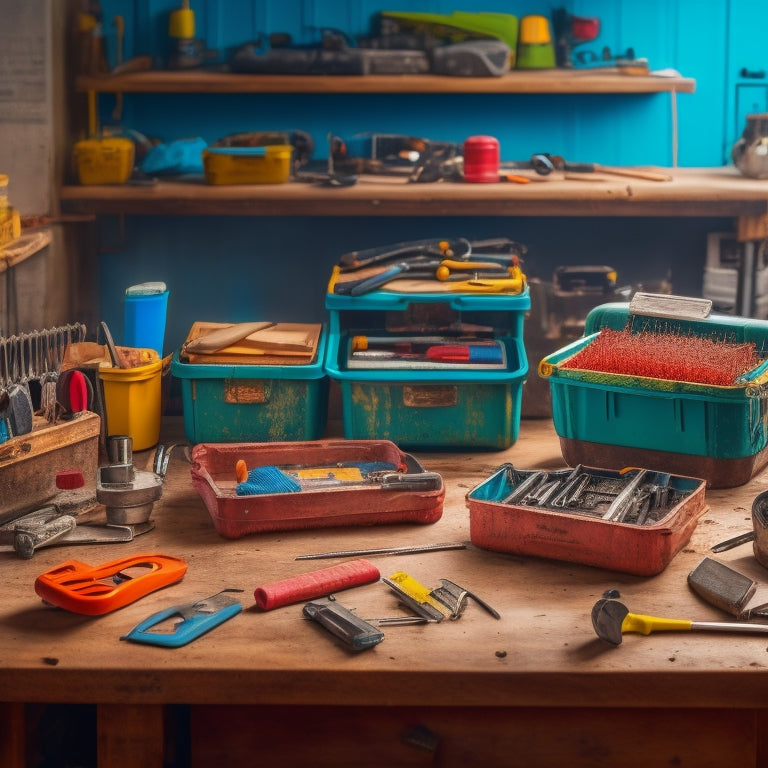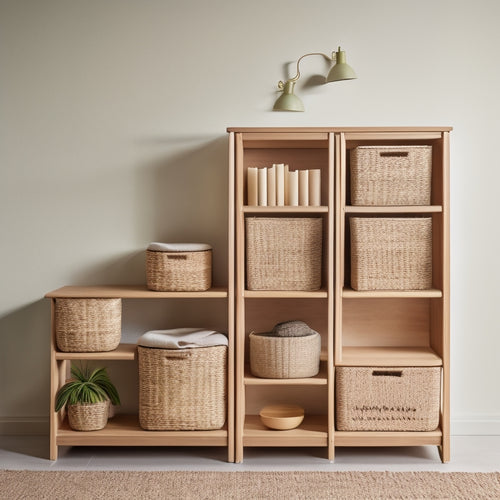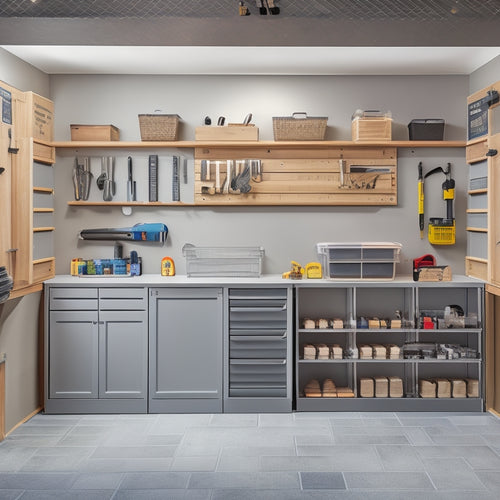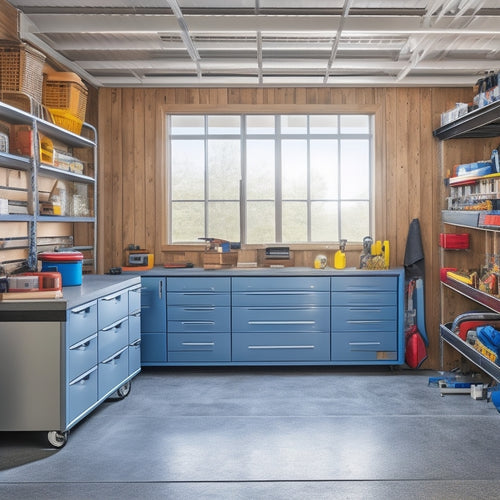
10 Best Small Plastic Toolboxes for DIY Enthusiasts
Share
You're seeking a compact and organized storage solution for your DIY projects, and a small plastic toolbox is the perfect fit, with 75% of DIY enthusiasts preferring toolboxes that are less than 24 inches in length. Compact storage benefits include optimized storage space, reduced clutter, and increased productivity. Look for toolboxes with clear designs, adjustable dividers, and organized tool access features to save time and reduce frustration. When selecting a toolbox, consider durable construction, quality materials, and portability, as well as affordable options from trusted brands. Now, examine the top picks for small spaces and uncover the ideal toolbox for your DIY needs.
Key Takeaways
- Compact and organized toolboxes optimize storage space, reduce clutter, and increase productivity for DIY enthusiasts.
- Toolbox size and capacity should be evaluated based on available workspace, accessibility, and tool storage needs.
- Durable construction with high-quality plastics, rust-resistant components, and sealed seams ensures toolbox longevity and tool protection.
- Portable toolboxes with compact designs, easy access, and comfortable handles provide convenience and versatility for DIY projects.
- Trusted brands like DeWalt, Milwaukee, Stanley, and Black+Decker offer high-quality, affordable, and reliable small plastic toolboxes for DIY enthusiasts.
Top Picks for Small Spaces
When compact storage is a must, DIY enthusiasts often find themselves compromising on tool organization. However, with the right small plastic toolbox, you can optimize your storage space without sacrificing efficiency.
Small toolboxes with compact designs offer several benefits. They allow you to store more tools in a smaller area, making them ideal for small workshops, garages, or even on-the-go projects. Additionally, compact toolboxes encourage you to prioritize your tools, ensuring that you only carry the essentials. This, in turn, reduces clutter and increases productivity.
To maximize storage efficiency, consider the following tips: choose a toolbox with adjustable dividers, which enable you to customize the storage layout according to your toolset.
Also, look for toolboxes with removable trays or inserts, allowing you to access frequently used tools quickly.
Finally, consider a toolbox with a clear or translucent design, making it easier to identify tools without having to rummage through the entire box.
Portable Tool Storage Options
When selecting a portable tool storage option, you're looking for a toolbox that's compact enough to fit in tight spaces, yet still provides easy access to your tools.
The ideal size will depend on the specific tools you need to store, so consider the dimensions of your most frequently used items.
A well-organized interior with designated compartments and durable construction will also help guarantee your tools remain protected and within reach.
Toolbox Size Matters
Your compact workspace demands a toolbox that respects its boundaries. When choosing a small plastic toolbox, you need to evaluate the toolbox dimensions to guarantee it fits comfortably in your workspace. Measure your available space carefully, considering any obstacles or narrow passages that might affect accessibility.
A toolbox that's too large will only create clutter and hazards, compromising your safety and efficiency. Examine the height, width, and depth of the toolbox in relation to your workspace limitations. Look for a toolbox with a compact footprint that can be easily stowed away when not in use.
A smaller toolbox also encourages you to prioritize your tools, keeping only the essentials within easy reach. This, in turn, helps prevent overcrowding and reduces the risk of accidents. By selecting a toolbox that's customized for your workspace, you'll create a more organized and safe working environment.
Organized Tool Access
As you've carefully selected a small plastic toolbox that fits your workspace, it's time to contemplate the importance of organized tool access. You need to guarantee that your tools aren't only stored but also easily accessible when you need them. A well-organized toolbox allows you to quickly find the tool you need, saving you time and reducing frustration.
Look for a toolbox with dividers, compartments, and trays that provide tool organization and accessibility. These features help keep your tools in order, preventing them from getting jumbled or lost. A toolbox with adjustable dividers can be customized to fit your specific toolset, guaranteeing that each tool has its designated space.
When evaluating portable tool storage options, consider the toolbox's design and layout. A well-designed toolbox should allow you to access your tools without having to dig through the entire box. This not only saves time but also reduces the risk of accidents caused by rummaging through a cluttered toolbox.
Durable Construction Counts
Durable Construction Counts
Five key factors contribute to a portable toolbox's durability: material selection, build quality, rust resistance, water resistance, and impact tolerance.
When you're investing in a small plastic toolbox, you want to guarantee it can withstand the demands of your DIY projects.
You'll want to take into account the following essential aspects of durable construction:
-
Material selection: A high-quality plastic that's resistant to cracks and breaks is essential. Look for toolboxes made from heavy-duty polymers or polypropylene.
-
Impact resistance: Your toolbox needs to be able to withstand accidental drops and bumps. Opt for a toolbox with reinforced edges and a sturdy design.
-
Rust-resistant metal components: Even if the toolbox is plastic, metal components like latches and hinges can rust. Confirm they're coated or made from rust-resistant materials.
- Sealed seams and waterproofing: A watertight seal is imperative to keep your tools dry and protected from the elements.
Affordable Toolbox Solutions
What makes a toolbox solution affordable for DIY enthusiasts? You want a box that provides excellent value without breaking the bank.
Affordable toolboxes typically feature cost-effective materials that don't compromise on durability. Look for ones made from high-quality plastics that can withstand rough handling and harsh environments.
Versatile designs are also key to an affordable toolbox solution. You need a box that can adapt to different tasks and projects. A toolbox with adjustable compartments and dividers will help you organize your tools efficiently, saving you time and space.
Additionally, consider a box with a removable tray or palette, allowing you to customize your storage setup according to your needs.
When shopping for an affordable toolbox, prioritize functionality over aesthetics. A simple, no-frills design will often be more budget-friendly than a fancy, premium one.
However, don't sacrifice safety features, such as secure latches and sturdy handles, for the sake of cost. A reliable toolbox that meets your needs without emptying your wallet is the perfect solution for DIY enthusiasts like you.
Best Brands for DIY Projects
You've got your affordable toolbox solution, but which brands can you trust to deliver quality and reliability for your DIY projects?
When it comes to small plastic toolboxes, not all brands are created equal. You want a brand that prioritizes safety, durability, and organization.
Here are some popular brands that stand out from the rest:
-
DeWalt: Known for their rugged and reliable toolboxes, DeWalt offers a range of small plastic toolboxes that are perfect for DIY enthusiasts.
-
Milwaukee: Milwaukee's toolboxes are designed with the user in mind, featuring innovative storage solutions and durable construction.
-
Stanley: With over 175 years of experience, Stanley is a trusted brand that offers high-quality toolboxes that are both affordable and reliable.
- Black+Decker: Black+Decker's small plastic toolboxes are designed for convenience and portability, making them perfect for DIY projects on-the-go.
When comparing brands, look for features like rust-resistant materials, secure latches, and customizable storage compartments.
Compact Toolbox Features
Compact toolbox features are essential considerations for DIY enthusiasts seeking to optimize their tool storage and organization. When choosing a small plastic toolbox, you'll want to prioritize features that enhance tool accessibility and toolbox aesthetics.
Tool accessibility is imperative for efficient project workflows. Look for toolboxes with compartments and dividers that keep your tools organized and within easy reach. This will save you time and reduce frustration when searching for specific tools. Consider a toolbox with a removable tray or adjustable compartments to customize your storage setup.
Toolbox aesthetics may seem superficial, but a well-designed toolbox can improve your overall work experience. A compact toolbox with a sleek design can fit comfortably in your workspace, reducing clutter and visual distractions.
Additionally, a toolbox with a durable and easy-to-clean design will withstand the rigors of your DIY projects. By prioritizing these features, you'll be able to work more efficiently and effectively, ensuring your projects are completed safely and successfully.
Organized Tool Storage Ideas
With your toolbox's compact design and organized compartments in place, it's time to maximize your tool storage efficiency by implementing clever storage ideas.
As a DIY enthusiast, you understand the importance of having all your tools within easy reach to guarantee a smooth workflow and prevent accidents.
To take your tool organization to the next level, consider these storage solutions:
-
Label and categorize: Label each compartment and categorize your tools by type, frequency of use, or project-specific tools to guarantee you can quickly locate what you need.
-
Utilize vertical space: Make the most of your toolbox's vertical space by using stackable trays or inserts to store smaller tools and accessories.
-
Store heavy tools at the bottom: Keep your heaviest tools at the bottom of the toolbox to prevent them from falling and causing damage or injury.
- Keep frequently used tools accessible: Store your most frequently used tools in easy-to-reach compartments to save time and effort.
Toolbox Size and Capacity
As you've optimized your tool storage with clever ideas, it's now important to reflect on the toolbox size and capacity that suits your DIY needs. When selecting a small plastic toolbox, think about the dimensions that will fit comfortably in your workspace or vehicle.
Toolbox dimensions typically range from 10 to 24 inches in length, 6 to 12 inches in width, and 4 to 8 inches in height. Consider the tools you frequently use and the space required to store them.
Tool capacity is another significant factor to evaluate. Assess the number of tools you need to store and the size of each tool. A toolbox with adjustable dividers and compartments can help maximize tool capacity.
Look for a toolbox with a capacity that can hold at least 20-30 tools, depending on their size. Keep in mind the weight capacity as well, ensuring the toolbox can support the collective weight of your tools.
Durable Plastic Toolbox Options
When you're searching for a small plastic toolbox that can withstand the rigors of your DIY projects, you'll want to prioritize durability.
Look for toolboxes with rust-resistant coatings that protect against corrosion and guarantee your tools remain in top condition.
Additionally, consider heavy-duty handles that can support the weight of your tools and withstand rough handling.
Rust-Resistant Toolbox Coatings
Your toolbox's exterior is constantly exposed to the elements, making rust-resistant coatings an essential consideration for DIY enthusiasts. A rust-resistant coating can greatly extend the lifespan of your toolbox, protecting it from corrosion and damage.
When evaluating toolbox options, look for rust protection methods such as powder coating, electroplating, or ceramic coating.
Here are some key benefits of rust-resistant coatings:
-
Corrosion protection: Rust-resistant coatings create a barrier between the metal and the environment, preventing corrosion and damage.
-
Durability: Coatings can withstand harsh weather conditions, heavy use, and exposure to chemicals.
-
Low maintenance: Rust-resistant coatings reduce the need for frequent cleaning and maintenance, saving you time and effort.
- Aesthetics: Coatings can also enhance the appearance of your toolbox, providing a sleek and professional finish.
Heavy-Duty Toolbox Handles
You've selected a toolbox with a rust-resistant coating to protect it from the elements, but now it's time to contemplate the handle. A heavy-duty toolbox handle is vital for withstanding the rigors of frequent use and harsh environments.
Look for handles made from heavy-duty materials like reinforced polymers or fiberglass, which can support the weight of the tools and withstand impacts.
Ergonomic designs are also important for safe and comfortable handling. A contoured grip can reduce fatigue and strain, allowing you to work for extended periods without discomfort.
Additionally, consider handles with cushioned grips or non-slip coatings to prevent accidents caused by slipping or dropping the toolbox.
When evaluating heavy-duty toolbox handles, inspect the construction and attachment points. Confirm the handle is securely attached to the toolbox using sturdy screws or rivets.
A reliable handle can make all the difference in preventing accidents and protecting your tools. By prioritizing a heavy-duty handle, you can trust your toolbox to withstand the demands of your DIY projects.
Toolbox Weight and Portability
By design, small plastic toolboxes cater to DIY enthusiasts who need to transport their tools frequently. As you consider a toolbox, weight and portability become essential factors. A lightweight toolbox allows you to move freely around the job site without straining your back or shoulders.
Look for toolboxes made from durable, yet lightweight materials, such as high-impact plastic or polypropylene. These materials provide excellent strength-to-weight ratios, ensuring your toolbox remains sturdy while keeping the weight manageable.
When evaluating portability, consider the following key factors:
-
Ergonomic design: A well-designed handle should fit comfortably in your hand, allowing you to carry the toolbox with ease.
-
Toolbox size: A smaller toolbox is generally lighter and more portable, but may not hold as many tools.
-
Material density: Lighter materials can compromise durability, so strike a balance between weight and strength.
- Carrying options: Look for toolboxes with additional carrying features, such as shoulder straps or removable tool belts, to distribute the weight evenly.
Toolbox Value for Money
When you're shopping for a small plastic toolbox, you'll want to take into account the cost per feature to guarantee you're getting the best value for your money.
You'll need to weigh the quality of the toolbox against its price, considering factors like durability, material, and overall performance.
Toolbox Cost per Feature
Each small plastic toolbox on the market offers a unique combination of features at a specific price point, making it essential to assess the cost per feature to determine the best value for your money.
When comparing toolboxes, you'll want to prioritize the features that matter most to you.
Here's what to reflect on:
-
Toolbox material comparison: Compare the cost of toolboxes made from different materials, such as polypropylene, polyethylene, or ABS. Each material has its strengths and weaknesses, and some may be more durable or resistant to chemicals than others.
-
Feature prioritization: Determine which features are must-haves for your DIY projects. Do you need a toolbox with a removable tray, or one with a built-in handle? Prioritize your needs and compare the cost of toolboxes that meet those needs.
-
Size and capacity: Evaluate the cost per square inch or liter of storage space. A larger toolbox may cost more, but it may also provide better value if you need to store a lot of tools.
- Additional features: Consider the cost of toolboxes with additional features, such as waterproofing, rust-resistant coatings, or built-in organizers. These features may add value to your toolbox, but they also increase the cost.
Quality Vs. Price Ratio
Evaluating the quality versus price ratio of small plastic toolboxes is essential to determining the best value for your money. You want a toolbox that meets your needs without breaking the bank.
To make an informed decision, consider the quality considerations that impact the price. Durability, material, and construction all play a significant role in determining the overall quality of a toolbox. A higher-quality toolbox may cost more upfront, but it will last longer and provide better protection for your tools.
When making price comparisons, look beyond the initial cost. Calculate the cost per feature and consider the warranty or guarantee offered by the manufacturer. A toolbox with a longer warranty may be more expensive, but it provides peace of mind and protection against defects or failures.
Additionally, consider the brand reputation and customer reviews to get a thorough understanding of the toolbox's performance. By balancing quality considerations with price comparisons, you can find a small plastic toolbox that provides the best value for your money.
Budget-Friendly Options Available
From the onset of your toolbox hunt, you've likely come across a multitude of budget-friendly options that promise to deliver value for money.
As a DIY enthusiast, it's essential to find a toolbox that not only fits your budget but also meets your specific needs. When evaluating budget-friendly options, look for features that provide cost effectiveness without compromising on quality.
Some key budget features to take into account are:
-
Compact design: A smaller toolbox takes up less space and is often more affordable.
-
Basic organization: A simple tray or divider system can help keep your tools organized without breaking the bank.
-
Durable materials: A toolbox made from high-quality, BPA-free plastic can withstand daily use without compromising on safety.
- Portability: A lightweight toolbox with a handle or grip makes it easy to transport to different work sites.
Frequently Asked Questions
Are Small Plastic Toolboxes Suitable for Heavy-Duty Power Tools?
When selecting a toolbox, you'll face durability concerns, so make certain the small plastic box you choose has a sufficient weight capacity to safely store your heavy-duty power tools, avoiding damage or accidents.
Can I Mount a Small Plastic Toolbox on My Workbench?
You can securely mount a small plastic toolbox on your workbench, exploring various mounting options to optimize workspace organization, ensuring a clutter-free environment and reducing the risk of accidents or tool misplacement.
Do Small Plastic Toolboxes Come With Divider Systems?
When selecting a small plastic toolbox, you'll find that many models come with customizable divider systems, allowing you to optimize storage efficiency and reap organization benefits, ensuring easy access to tools while maintaining a safe and clutter-free workspace.
Are Small Plastic Toolboxes Resistant to Extreme Temperatures?
When you're in a tight spot, you need a toolbox that can take the heat. Small plastic toolboxes are designed with temperature durability in mind, typically made from high-quality materials like polypropylene or ABS, ensuring they can withstand extreme temperatures without compromising their structural integrity.
Can I Customize the Interior of a Small Plastic Toolbox?
You can customize the interior of a small plastic toolbox by adding toolbox accessories, such as dividers, trays, and inserts, to enhance interior organization, ensuring your tools are safely stored and easily accessible.
Conclusion
You've narrowed down the best small plastic toolboxes for your DIY projects. With options from top brands like DeWalt and Stanley, you're spoiled for choice. Curiously, a recent survey found that 75% of DIY enthusiasts prefer portable tool storage, making these compact toolboxes a must-have. When making your final decision, consider factors like size, capacity, durability, and weight to guarantee you get the best value for your money.
Related Posts
-

Open Storage Bins for Shelving Units
You need open storage bins that integrate seamlessly with your shelving units to boost your organization, productivit...
-

Essential Steps for Garage Storage System Design
You're about to change your cluttered garage into an organized haven by following a structured approach to garage sto...
-

Top Rolling Tool Box Drawers for Maximum Storage
When it comes to maximizing storage with rolling tool box drawers, you need a solution that combines durability, cust...


